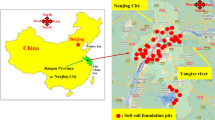Abstract
It is common that the deformation of an excavation slope leads to the displacement or even destruction of the surrounding buildings. An effective way to put an end to such accidents is to have adequate knowledge on the trigger factors of the deformation and failure of excavation slopes. Herein, taking the foundation pit slope at the Cultural Square in Badong County, China as an example, we carried out a site survey, including the engineering geology condition, the terrain change process, the spatial distribution characteristics of the surface crack and the construction process of the foundation pit. A further study was performed on the trigger factors, such as geological environment, earthquake, rainfall, fluctuation of reservoir level, human engineering activities, on ground surface deformation. The results show that the complex engineering geological condition and weak geological environment are the internal factors that lead to the deformation of the foundation pit slop. Earthquakes and fluctuations of reservoir level have little effect on this deformation, while rainfall and the excavation have a significant influence on it. The excavation process destroys the original geological environment and is thus the critical external factor inducing the formation and growth of crack, and rainfall intensifies the deformation.




















Similar content being viewed by others
References
Camera CAS, Apuani T, Masetti M (2014) Mechanisms of failure on terraced slopes: the Valtellina case (northern Italy). Landslides 11:43–54
Deng H, Kong J (2012) Spatiotemporal distribution characteristics of reservoir bank landslide deformation driven by rainfall. J Nat Disasters 21:148–154
Deng QL, Zhu ZY, Cui ZQ, Wang XP (2000) Mass rock creep and landsliding on the Huangtupo slope in the reservoir area of the Three Gorges Project, Yangtze River, China. Eng Geol 58:67–83
Dhakal AS, Sullivan K (2014) Shallow groundwater response to rainfall on a forested headwater catchment in northern coastal California: implications of topography, rainfall, and throughfall intensities on peak pressure head generation. Hydrol Process 28:446–463
Fayou A, Kong J, Ni Z (2012) Model test on deformation and failure of excavated anti-dip slope under seismic loading. Disaster Adv 5:41–47
Fernandez-Merodo JA, Garcia-Davalillo JC, Herrera G, Mira P, Pastor M (2014) 2D viscoplastic finite element modelling of slow landslides: the Portalet case study (Spain). Landslides 11:29–42
Jiang Q, Ye Z, Yao C, Zhou C (2012) A new variational inequality formulation for unconfined seepage flow through fracture networks. Sci China Technol Sci 55:3090–3101
Jiang Q, Yao C, Ye Z, Zhou C (2013) Seepage flow with free surface in fracture networks. Water Resour Res 49:176–186
Keqiang X, Depei Z, Haibo LI (2007) Physical modeling of deformation properties for soft rock slope under excavation. Rock Soil Mech 28(111–115):122
Luzi L, Pergalani F, Terlien MTJ (2000) Slope vulnerability to earthquakes at subregional scale, using probabilistic techniques and geographic information systems. Eng Geol 58:313–336
Matsuura S, Okamoto T, Asano S, Matsuyama K (2013) Characteristics of meltwater and/or rainfall regime in a snowy region and its effect on sediment-related disasters. Bull Eng Geol Environ 72:119–129
Miao H, Wang G, Yin K, Kamai T, Li Y (2014) Mechanism of the slow-moving landslides in Jurassic red-strata in the Three Gorges Reservoir, China. Eng Geol 171:59–69
Michalowski RL, Drescher A (2009) Three-dimensional stability of slopes and excavations. Geotechnique 59:839–850
Murphy W, Petley DN, Bommer J, Mankelow JM (2002) Uncertainty in ground motion estimates for the evaluation of slope stability during earthquakes. Q J Eng Geol Hydrogeol 35:71–78
Padilla C, Onda Y, Iida T, Takahashi S, Uchida T (2014) Characterization of the groundwater response to rainfall on a hillslope with fractured bedrock by creep deformation and its implication for the generation of deep-seated landslides on Mt. Wanitsuka, Kyushu Island. Geomorphology 204:444–458
Regmi AD, Yoshida K, Dhital MR, Devkota K (2013) Effect of rock weathering, clay mineralogy, and geological structures in the formation of large landslide, a case study from Dumre Besei landslide, Lesser Himalaya Nepal. Landslides 10:1–13
Saygili G, Rathje EM (2008) Empirical predictive models for earthquake-induced sliding displacements of slopes. J Geotech Geoenviron Eng 134:790–803
Strasser M, Anselmetti FS, Fah D, Giardini D, Schnellmann M (2006) Magnitudes and source areas of large prehistoric northern Alpine earthquakes revealed by slope failures in lakes. Geology 34:1005–1008
Thusyanthan NI, Madabhushi SPG, Singh S (2007) Tension in geomembranes on landfill slopes under static and earthquake loading-centrifuge study. Geotext Geomembr 25:78–95
Xin YAO, Chong XU, Fu-chu DAI, Yong-shuang Z (2009) Contribution of strata lithology and slope gradient to landslides triggered by Wenchuan Ms 8 earthquake, Sichuan, China. Geol Bull China 28:1156–1162
Zhang GC, Tang HM, Hu B (2007) Study of influence of unsaturated seepage on stability of landslide. Rock Soil Mech 28(5):965–970
Zhang T, Yan E, Cheng J, Zheng Y (2010) Mechanism of reservoir water in the deformation of Hefeng landslide. J Earth Sci 21:870–875
Acknowledgments
The financial support from the National Natural Science Foundation of China through research Grant No. 41102197 and No. 51209188 are gratefully acknowledged.
Author information
Authors and Affiliations
Corresponding author
Rights and permissions
About this article
Cite this article
Zhang, G., Xie, N., Tang, H. et al. Survey and cause analyses of ground surface deformation near a foundation pit slope: a case study in the Three Gorges area, China. Nat Hazards 75, 13–31 (2015). https://doi.org/10.1007/s11069-014-1261-x
Received:
Accepted:
Published:
Issue Date:
DOI: https://doi.org/10.1007/s11069-014-1261-x




